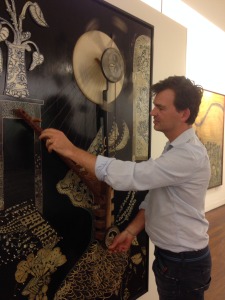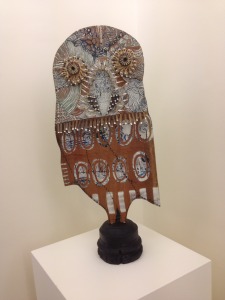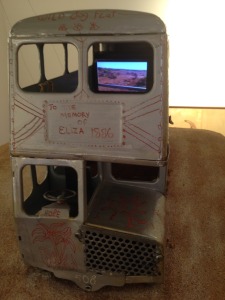Archive for September, 2014
Surrender to Joshua Yeldham’s exhibition at Manly Art Gallery and Museum
Sep 29th

Joshua Yeldham’s mid-career survey exhibition, Surrender, which was opened by actor Richard Roxburgh at the Manly Art Gallery and Museum on September 19, 2014, gave me the opportunity to meet and interview this extraordinary artist.
Yeldham creates much of his work on board his romantic old motor cruiser while it is moored on the lower reaches of the Hawkesbury River around Refuge Bay.
I asked Yeldham about his new book, also called Surrender, which was launched in tandem with his exhibition. The book is a peon to his 10-year-old daughter, Indigo, who was born after Joshua and his wife Jo went through the IVF program. Yeldham said he made a conscious decision to move to a watery environment while trying to conceive a child.
“That barren period was while I was in the desert, so it connected to the desert being the dried mother of all oceans,” he said.
When Yeldham began to dream of an owl which swooped down and stole his and Jo’s “potential children”, he drew on what he learned in his travels throughout North Africa and began making charms to appease the owl.

“Finally Joey became pregnant, and I started to celebrate the owl and give thanks to the owl and to make musical paintings that are owls that play music, which is melody, rhythm, repetition, learning to push through adversity and maintain navigation,” Yeldham said. “So the owls over 10 years have transcended from being ominous to being navigators for me. And also maternal.”
The owl is not a common Hawkesbury River inhabitant.
“They’re very secretive. All nature in the Kuringai is very secretive. It’s not an abundance of blatant wildlife. It’s like an ancient temple for me, the bush. It’s so removed from humanity and all that’s left is the traces of enormous forces that push boulders down gullies and forces of erosion and weathering of sandstone and tidal currents that don’t permit humans to last long there.”
Yeldham explained his philosophy, underlying all his art, that new life springs from destruction. He believes this is as true for human life as it is for, say, regeneration by fire in the Australian bush.
Yeldham spoke about growing up in Sydney’s eastern suburbs, and joyous holidays at his parents’ hobby farm on the Hawkesbury River at Ebenezer.
“When I was around 10, my mum and dad divorced and the farm became barren. The family unit stopped to exist. We still own the farm, but all of us let go of it because it contains such powerful memories and joyful memories and then in the separation it lost its fertility again, the ability that we would all grow as a family. And I wanted to reclaim the river as a new husband and as a father to my children and to teach my children the knowledge of the river, and it was a calling, really, to return.”

Yeldham sometimes takes his boat up to the old farm. But he gravitates to the “mangrove country” near Spencer and in the Kuringai country in locales such as Smiths Creek and Yeomans Bay. Yeldham said he loves the mangrove country because of its physical hostility as far as humans are concerned. “When I spent time in there, there’s no reference to human life. You can camp there and you’re lost in time.”
I asked if Yeldham goes to the river to paint alone. He said, emphatically, yes. “I go to the river to collapse and then create, which is creation coming out of the burn-off. That’s one of the most ancient stories any of us can access. And to not fight that process but to embrace it with great elemental awareness and gratitude.”
I asked Yeldham if he planned a sequel to his book, Surrender, that would mainly be for Jude, his six-year-old son, also born by IVF.
“That’s what everyone’s asking. We’re busting to do that. We’ve all been in Africa, all of us, since then, and it’s so much about my son the way he saw Africa and travelled. So yeah, why not?”
Elizabeth Fortescue, September 29, 2014
Jonathan Jones, Vincent Fantauzzo, Nick Stathopoulos and Justine Muller
Sep 13th
It’s been quite a big week for this visual arts writer in Sydney. Here’s how I saw it unfold:
On Tuesday morning I dropped into the NG Art Gallery in Chippendale to speak to Fiona White, whose exhibition titled Misfits I was to open the following night. http://www.ngart.com.au/artists_white.html
Fiona moved to Killcare on the Central Coast about four years ago, where she lives in a pole house on the side of the hill. Influenced by Mexican art and in particular Frida Kahlo, and also influenced by African naive art such as you see on the boards outside barber shops advertising different styles of hair cut, the paintings were pure flights of fancy.
Fiona borrows faces from “just everywhere”. She takes pictures in the street when she’s overseas, or she bases them on photographs in newspapers and magazines. People even send her photos. She looks for “a face that has character, or looks like it has a story”.
On Wednesday I interviewed artist Jonathan Jones, who was selected as the winner of Kaldor Public Art Projects’ competition, Your Very Good Idea. (My Daily Telegraph story on Jonathan Jones.) Jonathan, who used to be a curator of indigenous art at the Art Gallery of NSW, told me that his very good idea would focus on the Garden Palace which was located in the Royal Botanic Garden, Sydney, from 1879 until it burned down in 1882. The giant conflagration, a cinder from which set fire to a home in distant Potts Point, destroyed vast amounts of early historical documents and objects, including possibly thousands of indigenous artefacts gathered from around NSW and put on show in the Sydney International Exhibition which the Garden Palace had been built to display.
Jonathan told me that the loss of these objects has had a grievous impact, robbing today’s generations of indigenous people of the means to connect with many real objects from their heritage. I had no idea there were so few artefacts left.
On Thursday I went to the official announcement of Your Very Good Idea being won by Jonathan, which was held in the rose garden at the Royal Botanic Garden. The Garden Palace stretched, in fact, from the Conservatorium right across the gardens flanking Macquarie Street to the State Library — a gigantic footprint making it the most dominating building in Sydney at the time.
I ambled through the gardens to the Art Gallery of NSW to see who would win the Archibald People’s Choice.
It turned out to be Vincent Fantauzzo and his painting of his four-year-old son Luca ,which Vincent considered to be a self-portrait. Vincent’s very attractive wife, the actress Asher Keddie, accompanied him to the announcement and she stood to one side, somewhat bemused but obviously pleased, as her husband got the limelight. My story on Vincent Fantauzzo.
Going back to Wednesday, I went to St James’ railway station on the City Circle to interview Justine Muller, an artist who was brought up with an instinct for heritage, largely thanks to her mother and father who ran the East Sydney Hotel and knew Jack Mundey, the hero of the 1970s green bans. Muller is, in fact, Mundey’s Goddaughter. Muller’s large-scale drawings were of people she spotted around Millers Point, where vast numbers of people who have lived in the area have been forcibly displaced to make way for gentrification by the State Government.
The drawings were being hung inside glass cabinets along the platforms of the station, and looked fabulous. I’m sure commuters will love them. The exhibition was under the auspices of the Conductors Project run by Tristan Chant. It was the first time the Conductors Project has taken over both platforms at the station, Chant told me. My story on Justine Muller.
Thursday night saw the announcement of Nick Stathopoulos’ painting of author Robert Hoge as the winner of the People’s Choice in the Salon des Refuses. This is a wonderful picture (see left), heartfelt and sensitive, and Nick tells me a documentary is being made about its creation. This is going to be one to watch out for. 
Finally, on Friday, I ducked down to Oxford St, Darlinghurst, to meet Emilya Colliver of Art Pharmacy, an on-line art sales business which has occasional pop-up exhibitions like the one I was about to see. I thought Emilya very enterprising, having tapped into the willingness of art buyers to buy on-line. Emilya said it was only works in the hundreds of</a> dollars that sold on-line, after which people tended to prefer to see the works in person before buying.
Finally, the Australian Museum has a brilliant new show on the Aztecs. My Aztecs story here.
Elizabeth Fortescue, September 15, 2014
